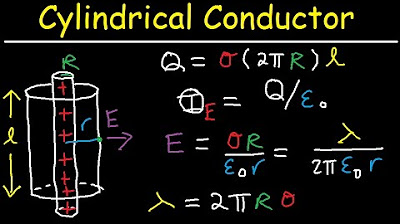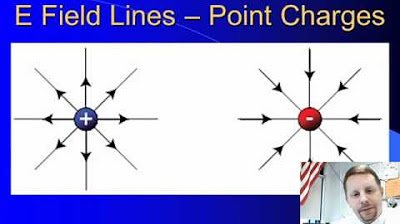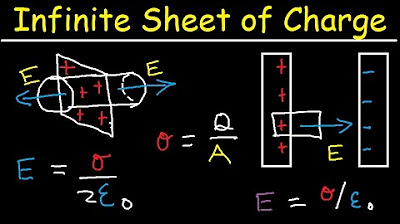Electric Field Due to a Line of Charge - Finite Length - Physics Practice Problems
TLDRThis educational video script delves into calculating the electric field due to a finite line of charge. It introduces the concept of linear charge density and guides viewers through deriving equations for the electric field components in the x and y directions. The script simplifies the process using trigonometric and u-substitutions for integration, ultimately focusing on practical examples to illustrate the calculation of electric fields at specific points relative to a charged rod.
Takeaways
- 📚 The video focuses on calculating the electric field due to a finite line of charge, contrasting with the case of an infinitely long rod.
- 🔍 It emphasizes the importance of understanding two types of problems: one with an infinitely long rod and the other with a rod of finite length.
- 📈 The process begins by deriving equations for the electric field at a point due to a small segment of charge on the rod.
- 📐 The electric field vector has both x and y components, but due to symmetry, the net electric field in the y direction is zero.
- ⚖️ The linear charge density (λ) is defined as the total charge (q) divided by the total length (l) of the rod, measured in coulombs per meter.
- 🔗 The electric field produced by a point charge is given by the formula kq/r^2, where k is Coulomb's constant, q is the charge, and r is the distance from the charge.
- 📉 The electric field in the x direction (Ex) is calculated by integrating the contribution from each small charge segment (dq) along the rod.
- 📚 Trigonometric substitution is used to integrate the expression for the x-component of the electric field, simplifying the complex integral.
- 📝 The final expression for Ex is derived and involves the variables x, a (half the length of the rod), and the total charge q.
- 🔍 The script demonstrates how to calculate the electric field at a point for a rod of finite length using specific examples.
- 📘 The video concludes with a review of the key equations needed for these types of problems, including the electric field in the x direction and linear charge density.
Q & A
What are the two types of problems involving electric fields due to a line of charge?
-The two types of problems are those involving an infinitely long rod and those involving a rod with a finite length.
What is the primary focus of the video script?
-The primary focus is on calculating the electric field due to a line of charge with finite length, deriving the equations, and working on practice problems.
How is the electric field vector at point P determined?
-The electric field vector at point P is determined by considering the contributions from each small segment of the rod and summing their individual electric field vectors in the x and y directions, taking into account the symmetry of the rod.
What is the significance of the linear charge density (λ) in this context?
-The linear charge density (λ) represents the charge per unit length of the rod, calculated as the total charge (q) divided by the total length (2a) of the rod.
How is the charge dq of a small segment of the rod related to the total charge q?
-The charge dq of a small segment is related to the total charge q by the linear charge density, dq = λ * dy, where dy is the length of the small segment.
What is the formula for the electric field (dE) produced by a small segment of charge?
-The electric field produced by a small segment of charge is given by dE = k * (dq) / r^2, where k is Coulomb's constant, dq is the charge of the segment, and r is the distance from the segment to the point of interest.
Why is the net electric field in the y direction zero for a symmetric rod?
-The net electric field in the y direction is zero due to the symmetry of the rod, where equal and opposite charges produce electric fields that cancel each other out in the y direction.
What is the integral expression for calculating the electric field in the x direction (Ex)?
-The integral expression for Ex is k * q / (2a) * integral from -a to a of (x * dy) / ((x^2 + y^2)^(3/2)).
What trigonometric substitution is used to simplify the integral for Ex?
-The trigonometric substitution used is y = x * tan(θ), which also leads to dy = x * sec^2(θ) dθ.
How do you prove that the electric field in the y direction (Ey) is zero for a symmetric rod?
-Ey is proven to be zero by integrating the expression for dEy over the length of the rod and showing that the contributions from the upper and lower halves of the rod cancel each other out, resulting in a net Ey of zero.
What is the final formula for the electric field in the x direction (Ex) for a finite rod?
-The final formula for Ex is k * q / (x * sqrt(x^2 + a^2)), where a is half the length of the rod.
How is the linear charge density used to express the electric field formula in terms of λ?
-By substituting q with λ * (2a) in the electric field formula, Ex can also be expressed as 2 * k * a * λ / (x * sqrt(x^2 + a^2)).
What is the process for calculating the electric field at a point not on the centerline of a rod?
-For points not on the centerline, the process involves using the derived equations for Ex and Ey, applying appropriate limits of integration, and using trigonometric or u-substitution to solve the integrals.
Outlines
🔍 Introduction to Calculating Electric Field of a Finite Charged Rod
This paragraph introduces the topic of calculating the electric field due to a finite line of charge, distinguishing it from the case of an infinitely long rod. The focus is on deriving equations for the electric field at a point on the central axis of the rod, specifically at the center. The process involves breaking down the rod into small segments, each with a charge dq, and using symmetry to simplify the calculation, concluding that the net electric field in the y direction is zero due to the rod's symmetry.
📚 Derivation of Electric Field Equations for a Charged Rod
The paragraph delves into the mathematical derivation of the electric field produced by a small segment of a charged rod. It explains the relationship between linear charge density (lambda), total charge (q), and rod length (2a). The electric field dE due to a segment is expressed in terms of dq, the distance from the segment to point P (r), and the angle θ between the segment and the line to point P. The paragraph concludes with the integral expression for the x-component of the electric field (Ex), setting the stage for the integration process.
🧭 Trigonometric Substitution for Electric Field Integration
This section describes the process of integrating the expression for the x-component of the electric field using trigonometric substitution. The substitution y = x * tan(θ) is introduced to simplify the integral, transforming it into a more manageable form. The paragraph explains the process of differentiating y with respect to θ, substituting dy, and simplifying the integral to isolate the variable θ. The goal is to find the anti-derivative that will yield the expression for Ex.
📉 Evaluating the Integral for the Electric Field in the x-Direction
The paragraph focuses on evaluating the integral for the x-component of the electric field from the bottom to the top of the rod. It explains how to use the limits of integration (from -a to a) and how to handle the trigonometric expressions that arise from the substitution. The integral is simplified to a form that can be evaluated, leading to the expression for Ex in terms of the rod's total charge q, its length 2a, and the position x.
🔎 Proving the Electric Field in the y-Direction is Zero
This section discusses the proof that the electric field in the y-direction (Ey) is zero due to the symmetry of the rod. It starts by expressing the differential electric field in the y-direction (dEy) in terms of the differential electric field in the x-direction (dEx) and the sine of the angle θ. The paragraph then integrates dEy over the length of the rod, using u-substitution to simplify the integral, and shows that the result is zero, confirming the symmetry-based expectation.
🔄 Recap of Equations for Calculating the Electric Field of a Charged Rod
The paragraph provides a recap of the key equations needed to calculate the electric field of a finite charged rod. It emphasizes the formula for the x-component of the electric field (Ex), the relationship between linear charge density (λ) and total charge (q), and the total length of the rod (l). The summary serves as a quick reference for the formulas that will be used to solve practice problems.
📝 Solving Practice Problems Involving Electric Fields of Charged Rods
This paragraph presents two practice problems involving the calculation of the electric field for a finite charged rod. The first problem involves a rod with a given length and total charge, requiring the calculation of the electric field at a specified distance from the center. The second problem starts with the linear charge density and rod length, leading to the calculation of the total charge and subsequently the electric field at a given point. The solutions demonstrate the application of the previously discussed equations.
🔚 Conclusion and Preview of Future Content
The final paragraph concludes the video by summarizing the content covered on calculating the electric field of a finite charged rod. It also teases upcoming content on the electric field of an infinitely long rod, indicating a continuation of the topic in future videos.
Mindmap
Keywords
💡Electric Field
💡Line of Charge
💡Linear Charge Density
💡Infinite Rod
💡Finite Length
💡Electric Field Vector
💡Segment of Charge
💡Symmetry
💡Trigonometric Substitution
💡Integral
💡Coulomb's Law
Highlights
The video focuses on calculating the electric field due to a line of charge, specifically for finite length rods.
Two types of problems are discussed: infinitely long rods and finite length rods, with the video concentrating on the latter.
The process begins with deriving equations for the electric field, followed by solving practice problems.
A rod with uniformly distributed charge is considered, and the electric field at its center is calculated.
The concept of linear charge density (lambda) is introduced as the charge per unit length of the rod.
The electric field components in the x and y directions are discussed, with the net electric field in the y direction being zero due to symmetry.
The Pythagorean theorem is applied to find the distance from a charge segment to point P.
The electric field due to a small charge segment (dE) is derived using Coulomb's law and trigonometric relationships.
Integration is used to find the total electric field in the x direction (Ex) by summing the contributions from all segments.
Trigonometric substitution is recommended for integrating the complex function involving the electric field components.
The electric field in the x direction is simplified to a formula involving the charge, distance, and rod length.
The electric field in the y direction (Ey) is proven to be zero through integration and symmetry arguments.
The video provides equations for calculating the electric field and linear charge density in terms of given parameters.
An example problem calculates the electric field 60 cm from the center of a 1.5m rod with a 150 nC total charge.
The linear charge density is calculated in a follow-up example using the total charge and rod length.
The video concludes with a summary of the key equations and methods for calculating the electric field of a finite length rod.
Transcripts
Browse More Related Video

Gauss Law Problems, Cylindrical Conductor, Linear & Surface Charge Denisty, Electric Field & Flux,

High School Physics - Electric Fields

How To Draw Electric Field Lines of Point Charges - College Physics

Gauss Law Problems - Infinite Sheet of Charge and Parallel Plate Capacitor - Physics

Electric Field (1 of 3) An Explanation

Electric Fields: Crash Course Physics #26
5.0 / 5 (0 votes)
Thanks for rating: